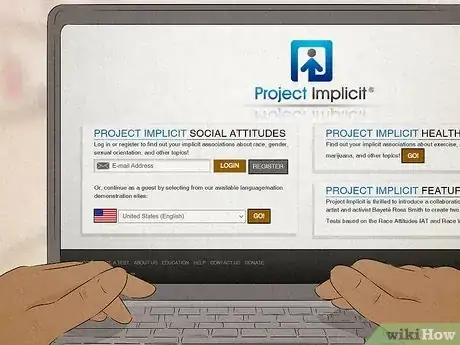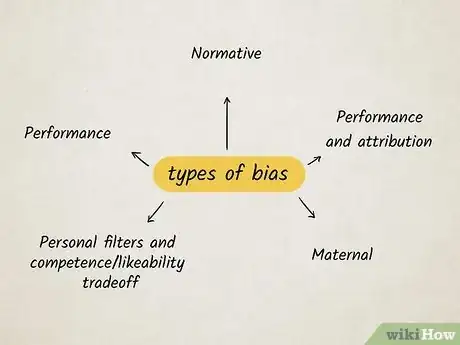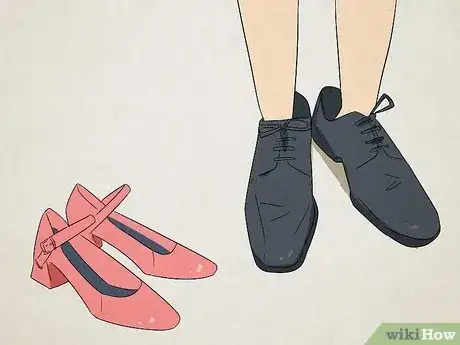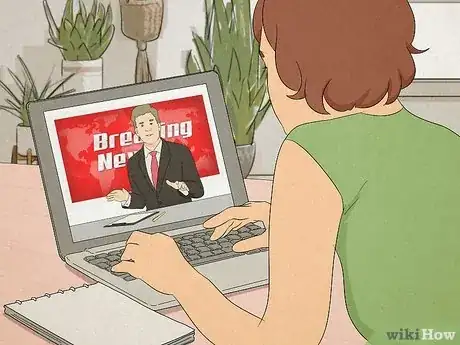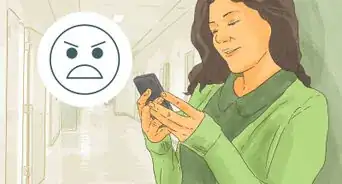This article was co-authored by Trudi Griffin, LPC, MS. Trudi Griffin is a Licensed Professional Counselor in Wisconsin specializing in Addictions and Mental Health. She provides therapy to people who struggle with addictions, mental health, and trauma in community health settings and private practice. She received her MS in Clinical Mental Health Counseling from Marquette University in 2011.
wikiHow marks an article as reader-approved once it receives enough positive feedback. In this case, several readers have written to tell us that this article was helpful to them, earning it our reader-approved status.
This article has been viewed 270,830 times.
Buried prejudice and biases influence our feelings, decisions, and behavior in sometimes surprising ways. Recognizing and overcoming these biases can be challenging, but is an important process when trying to be a tolerant, open-minded person. Start by labeling and realistically confronting the biases you have. Once you’ve done that, you can work to change your thought patterns and behavior to make steps toward overcoming prejudice.
Steps
Identifying Your Biases
-
1Pay attention to your reactions to people, news, social media posts, etc. Noticing the way that you react to things in your everyday life can help you to identify your biases. Anytime you encounter a person, news story, social media post, or new situation, pay attention to how you react to it. How did it make you feel? What did you do in response?
- For example, if you encounter a picture of someone who is obese and you notice that you reacted with disgust, then you may have some hidden prejudice against people who are overweight.
- Keep in mind that identifying unconscious biases can be a difficult process because they are unconscious. But by making a conscious effort to notice your responses to different people and situations, you may begin to identify your unconscious biases.
-
2Take the Implicit Associations Test. The IAT is a set of questionnaires that can examine your level of bias related to things like gender, sexuality, ethnicity, religion, body type, and more. Based on the answers you select, the IAT will report back to you the degree to which bias impacts your thoughts on these topics.[1]
- The IAT is available online, free of charge, via Project Implicit.
- Researchers have indicated that the IAT has shortcomings, however. Keep in mind that the test is controversial and imperfect. Use it as a starting point to think about your biases, but not as an official judgment of them.[2]
Advertisement -
3Label stereotypes that impact your biases. Finding out that you have biases against certain people can make you feel many things, from denial to shame. If you want to overcome these biases, however, the first step is having the courage to call them what they are.[3]
- Remind yourself that everyone harbors certain biases, and that we can all work to treat others in more tolerant, open-minded, and respectful ways.
- Also, watch for stereotypes in the media. For example, if you are uninformed about gun rights, but you find yourself agreeing with media that says guns are bad and gun owners are right-wing fundamentalists, then you may be buying into stereotypes about gun ownership.
-
4Combat your positive stereotypes as well. It’s easy to think of biases as negative perceptions. A negative bias means something like thinking that women do not drive as well as men, or that one race is more prone to criminal activity than another. Having unfounded positive biases against people can also lead to discrimination, however.[4]
- For example, a teacher who subconsciously assumes that people of Asian descent are good at math might overlook a student who actually is struggling.
-
5Learn about the different types of bias. Overcoming unconscious biases is a complex process because there are so many different types of biases and they manifest in different ways. To make it easier for you to identify when you may be showing an unconscious bias, learn about the different types of bias and how they usually manifest. These types include:[5]
- Normative bias. Having an idea of how things ought to be or how a person should be, which affects your ability to see the positives of things that are outside of these definitions.
- Performance bias. Overestimating someone’s abilities based on their background, such as by associating a person’s name with experience in their field.
- Confirmation bias. Looking for information that will confirm a bias, such as by scanning a person’s Facebook profile for evidence that what you think about them is true.
- Performance and attribution bias. Attributing the success of someone from a high performance group to their abilities, and attributing the success of someone from a low performance group to the help they received from other people.
- Personal filters and competence/likeability tradeoff. Assessing someone based on how much you like them or think they would fit in with your community, rather than by looking at their actual qualifications.
- Maternal bias. Doubting someone’s commitment to their chosen field because of things like their age, sex, ethnicity, sexual orientation, family status, or disability.
-
6List ways that unconscious and hidden biases impact your behavior. If you can see specific ways that biases relate to your actions, you may be more motivated to overcome them. Whatever roles you have in society, stop and think about how you unconsciously act on your biases, once you’ve identified them. For example:[6]
- If you are a police officer, how does bias impact the work you do in your community?
- If you are a manager, what effect do your biases have on how you oversee your employees, hiring, etc.?
- As a citizen, do you alter your behavior around certain types of people? For example, are you more likely to avoid eye contact with certain groups? Are you more talkative with or friendly to strangers of one type than another?
Altering Your Patterns of Thought
-
1Learn to recognize and avoid generalizations. Remember that not everyone in a group, community, or organization is the same. Whenever you find yourself making a generalization about a group of people, stop yourself. Ask yourself why you think that way and change your perspective.
- Ask yourself, "is it really possible that every single member of this group is the same?" The answer is most likely "no."
- For example, you might find yourself thinking that a certain group of people are loud. Why do you think that? Consider that perhaps it is just an individual from that group who is loud. Change your thinking from "all people in this group are loud" to "one person from this group I met was very loud" or even "a few (but not all) people from this group are loud."
-
2Counter stereotypes with positive images. Think of a bias that you have, and the stereotype that causes that bias. Then, imagine the opposite image of that stereotype. For instance:[7]
- If you have a bias toward considering African Americans more athletic than intellectual, make a point to think of real or imagined individuals who challenge that stereotype.
- For example, you might imagine your influential African American chemistry teacher, or a public intellectual like Cornell West.
-
3Practice individuation. In terms of biases, individuation means giving a “face” or personality to members of a group, rather than making assumptions that lump them all together. For instance, if you find yourself affected by biased thoughts against women, make associations with specific individuals.[8]
- For instance, if you find yourself thinking that women are materialistic, ask yourself whether or not this applies to specific women in your life, like your mother, your pharmacist, your city’s police chief, or a clerk at the store.
-
4Expose yourself to the people and things that make you feel uncomfortable. By learning more about a person, lifestyle, or topic that you disagree with or that you have noticed yourself exhibiting bias towards, you can begin to build compassion.
- For example, if you find yourself feeling disgusted by people who are obese, then research some of the causes of obesity to build your understanding of how people get that way.
- If you find yourself frustrated every time you see a post about gun ownership, then research the issues that gun owners care about, such as by visiting the NRA’s website.
-
5Put yourself in others’ shoes. Also known as “perspective taking,” this technique is a great way to lessen the impact of judgments you might make automatically. For instance, if you feel biased in thinking that people with kids are no fun:[9]
- Take a moment to imagine the busy schedules and demands of parents.
- Ask yourself if their idea of fun might simply be different from your own. Watching Harry Potter with a bowl of popcorn might seem boring to you, but it might be lots of fun with kids around.
-
6Focus on concrete factors rather than gut feelings. Whether they’re positive or negative, gut feelings can sometimes lead us astray. When you feel the impact of a bias, challenge these gut feelings by looking at concrete factors.
- For instance, if you find yourself walking quickly past someone of another group, ask yourself: is there anything that person is actually doing to make me feel threatened?
- Keep in mind how your biases impact how you view situations, however. For instance, a smile from someone belonging to a group you are more accepting of might seem fine. Your biases might make a smile from someone of another group seem threatening.
-
7Think positive thoughts around people you have stigmatized. Consciously adopting more positive thoughts can be a very good way to combat negative biases. For instance, you might imagine that you have a bias that makes you feel uncomfortable with men taking care of small children. Whenever you see a man in a positive caregiving role, make a point of consciously noting this.
Making Life Changes
-
1Increase opportunities for contact with a diverse range of people. If you spend all of your time around people who are just like you, it will be harder to overcome the biases you have. Getting to know people who are different from you can be a powerful way to foster understanding and acceptance.[10]
- Make friends with lots of different kinds of people. Make a point of inviting them to events to get to know them better. For example, you could invite everyone in your neighborhood to a block party, or reach out to other parents at your child's school to host a picnic at a local park.
- Get involved with organizations in your community that bring diverse people together (or start one!).
-
2Learn from people who are more tolerant than you. The old saying is that hate breeds hate, but the reverse is true, too: tolerance breeds tolerance. If you are concerned about your unconscious and hidden biases, think of people you know who seem especially open. Spend time around them, and you’ll be more motivated to break down your own biases.[11]
-
3Surround yourself with open-minded media. Just like individuals, media services (television channels, internet sites, podcasts, radio stations, etc.) all have some degree of bias. Some promote these biases, consciously or unconsciously, while others have a goal of trying to be open-minded.[12]
- Pay careful attention to the media sources you use. If you hear prejudicial or discriminatory language, seek other sources.
- Look for other types of bias in the media as well. For instance, does a news show interview a diverse range of people, or only those who look, think, or believe a certain way? Does it report on a wide range of issues, or only a narrow set of interests?
References
- ↑ https://implicit.harvard.edu/implicit/
- ↑ http://nymag.com/scienceofus/2017/01/psychologys-racism-measuring-tool-isnt-up-to-the-job.html
- ↑ https://www.nccpsafety.org/assets/files/library/Understanding_Bias-A_Resource_Guide.pdf
- ↑ https://www.psychologytoday.com/blog/in-practice/201508/6-ways-overcome-your-biases-good
- ↑ https://www.ryerson.ca/content/dam/equity/documents/Types-of-Unconscious-Biases-and-Ways-to-Counteract.pdf
- ↑ https://www.psychologytoday.com/blog/in-practice/201508/6-ways-overcome-your-biases-good
- ↑ https://www.nccpsafety.org/assets/files/library/Understanding_Bias-A_Resource_Guide.pdf
- ↑ https://www.nccpsafety.org/assets/files/library/Understanding_Bias-A_Resource_Guide.pdf
- ↑ https://www.nccpsafety.org/assets/files/library/Understanding_Bias-A_Resource_Guide.pdf

